
Imagery intelligence (IMINT), pronounced as either as Im-Int or I-Mint, is an intelligence gathering discipline wherein imagery is analyzed to identify information of intelligence value. Imagery used for defense intelligence purposes is generally collected via satellite imagery or aerial photography.

Defence Intelligence (DI) is an organisation within the United Kingdom intelligence community which focuses on gathering and analysing military intelligence. It differs from the UK's intelligence agencies in that it is an integral part of a government department – the Ministry of Defence (MoD) – rather than a stand-alone organisation. The organisation employs a mixture of civilian and military staff and is funded within the UK's defence budget. The organisation was formerly known as the Defence Intelligence Staff (DIS), but changed its name in 2009.
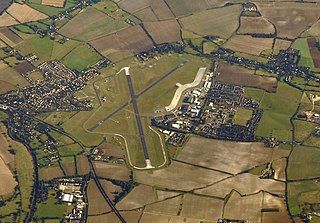
Royal Air Force Benson or RAF Benson is a Royal Air Force (RAF) station located at Benson, near Wallingford, in South Oxfordshire, England. It is a front-line station and home to the RAF's fleet of Westland Puma HC2 support helicopters, used primarily for the transportation of troops & equipment. Flying squadrons comprise No. 33 Squadron flying the Puma, No. 22 Squadron which provides operational evaluation and training for all aircraft in Joint Helicopter Command and No. 28 Squadron, which is the combined Puma and Boeing Chinook HC6A training unit. Other units include the Oxford University Air Squadron and No. 6 Air Experience Flight, both flying the Grob Tutor T1 light training aircraft used for student and cadet flying training. The National Police Air Service and the Thames Valley Air Ambulance are also based at the station, both operating Airbus H135 helicopters.

RAF Brampton was a non-flying Royal Air Force installation near Huntingdon in Cambridgeshire, England. Formerly the home of RAF Support Command, it also became the home of several elements of Defence Equipment & Support (DE&S), which itself was a result of a merger between the Defence Logistics Organisation (DLO) and the Defence Procurement Agency (DPA), and provided a base for the Defence Security & Assurance Services and Defence Estates.

Royal Air Force Wyton or more simply RAF Wyton is a Royal Air Force station near St Ives, Cambridgeshire, England. The airfield is decommissioned and is now used by the UK Strategic Command.
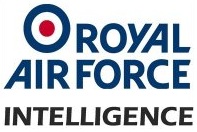
Intelligence services in the Royal Air Force are delivered by Officers of the Royal Air Force Intelligence Branch and Airmen from the Intelligence Analyst Trade and Intelligence Analyst (Voice) Trade. The specialisation has around 1,200 personnel of all ranks posted to operational air stations, HQs and other establishments of the British Armed Forces, both in the United Kingdom and overseas.
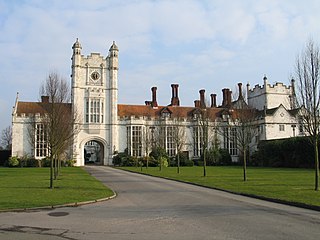
RAF Medmenham is a former Royal Air Force station based at Danesfield House near Medmenham, in Buckinghamshire, England. Activities there specialised in photographic intelligence, and it was once the home of the RAF Intelligence Branch. During the Second World War, RAF Medmenham was the main interpretation centre for photographic reconnaissance operations in the European and Mediterranean theatres.
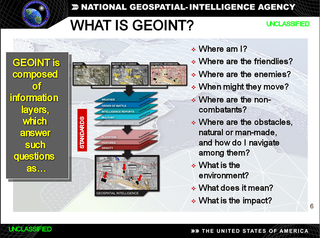
In the United States, geospatial intelligence (GEOINT) is intelligence about the human activity on Earth derived from the exploitation and analysis of imagery, signals, or signatures with geospatial information. GEOINT describes, assesses, and visually depicts physical features and geographically referenced activities on the Earth. GEOINT, as defined in US Code, consists of imagery, imagery intelligence (IMINT) and geospatial information.

The United Kingdom's Strategic Command (StratCom), previously known as Joint Forces Command (JFC), manages allocated joint capabilities from the three armed services.
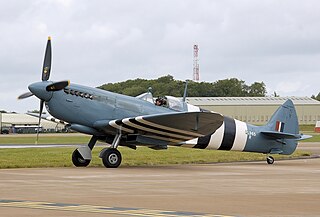
MI4 was a department of the British Directorate of Military Intelligence, Section 4, part of the War Office. It was responsible for aerial reconnaissance and interpretation. It developed into the JARIC intelligence agency. The present day successor agency to MI4 is the Defence Intelligence Fusion Centre.
RAF Brampton Wyton Henlow is a former Royal Air Force unit covering three distinct sites in Cambridgeshire and Bedfordshire. The three sites, separately known as RAF Brampton, RAF Wyton and RAF Henlow, housed a number of flying training, intelligence, security and other RAF support organisations. On 2 April 2012 the unit was disbanded with RAF Brampton being renamed Brampton Camp RAF Wyton.
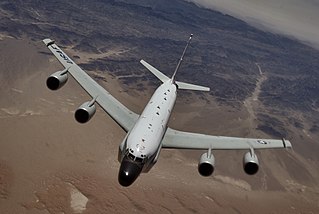
Signals intelligence operational platforms are employed by nations to collect signals intelligence, which is intelligence-gathering by interception of signals, whether between people or between machines, or mixtures of the two. As sensitive information is often encrypted, signals intelligence often involves the use of cryptanalysis. However, traffic analysis—the study of who is signalling whom and in what quantity—can often produce valuable information, even when the messages themselves cannot be decrypted.
No. 7010 (VR) Photographic Interpretation Squadron, Royal Auxiliary Air Force is a unit of the British Royal Air Force. It was founded in April 1953 as No. 7010 Flight, Royal Air Force Volunteer Reserve, to provide strategic imagery analysis support to the Royal Air Force. In 1965 the flight expanded its role to include tactical imagery analysis. In August 1982, Her Majesty The Queen approved the issue of a badge to the flight. In allusion to the unit's role, the emblem of a human eye is portrayed with a wing embellishment and set in front of a roundel. The motto Vocati Veniemus may be freely translated as "when summoned we shall be there". The collapse of the Warsaw Pact resulted in a large reduction of NATO forces in central Europe. In turn this has led to a major reduction in, and reorganisation of, the United Kingdom's regular and reserve forces. Within this overall plan for defence, No. 7010 Flight became No. 7010 (VR) Photographic Interpretation Squadron.
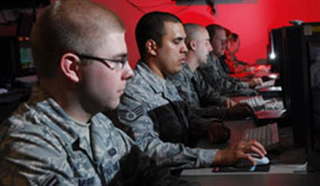
The United States Air Force's 497th Intelligence, Surveillance and Reconnaissance Group is an intelligence unit located at Joint Base Langley–Eustis, Virginia.

No. 1 Photographic Reconnaissance Unit was a flying unit of the Royal Air Force, first formed in 1940.

The 24th Intelligence Squadron is an active United States Air Force unit stationed at Ramstein Air Base, Germany. The squadron was first activated as the 24th Observation Squadron during World War II. it conducted aerial reconnaissance training, until converting to the photographic mission as the 33d Photographic Reconnaissance Squadron. it deployed to the European Theater of Operations, where it conducted combat reconnaissance missions, earning a Distinguished Unit Citation and being cited in the Belgian Army Order of the Day on two occasions. It remained in Europe following V-E Day, becoming non operational in August 1945. Its ground echelon returned to the United States in the fall of 1945 and it was inactivated at the port of embarkation.

Royal Air Force Alconbury, or more simply RAF Alconbury, is an active Royal Air Force station near Huntingdon, England. The airfield is in the civil parish of The Stukeleys, close to the villages of Great Stukeley, Little Stukeley, and Alconbury. Flying operations are no longer based at the site, with most of the land, including the runway, having been sold in 2009 to become the new settlement of Alconbury Weald.
This is the structure of the British Armed Forces, as of October 2021.

United Kingdom Space Command (UKSC) is a joint command of the British Armed Forces organised under the Royal Air Force, and staffed by personnel from the Royal Navy, British Army, Royal Air Force and the British Civil Service. The UKSC has three functions: space operations, space workforce generation, and space capability.

















